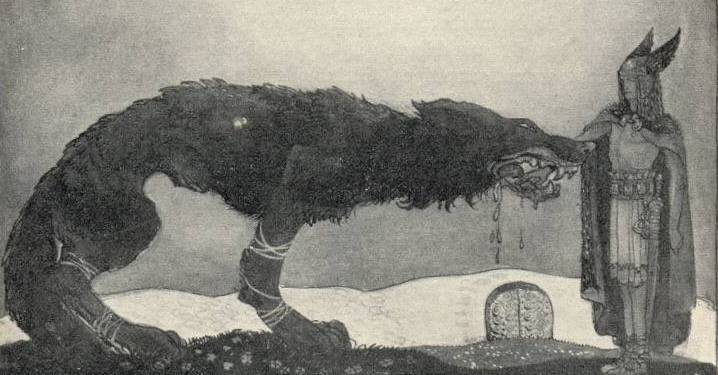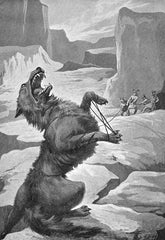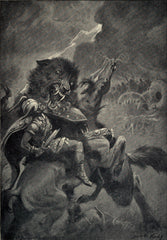on all orders over $100
on all orders over $100

In Norse Mythology Fenrir, also known as 'Fenrisúlfr' in Old Norse, which translates to 'Fenris Wolf' in modern English, was a giant dire-wolf who featured in Norse Sagas.
Fenrir was described in the stories as being an abnormally large wolf, in the Prose Edda it was said that the Gods who raised him were astonished by his rapid rate of growth and his supernatural strength. In the prophecy of Ragnarok Fenrir was said to rampage across the world with his lower law on the earth and his upper jaw in the sky, which gives us some insight into the magnitude of this colossal canine.
There was a recurring theme in Norse Mythology of giant monstrous animals who were subdued and bound by the Aesir, only to return at Ragnarok and enact their revenge upon the Gods. Fenrir was one such creature.
The iconic wolf has been the inspiration for many characters in later works of fiction who featured in various books and movies, most notably the Lord of the Rings trilogy, the Harry Potter universe and the Thor Ragnarok movie.
Fenrir was one of the sons of Loki, the trickster God of Norse Mythology. His mother was a Jotun giantess named Angrbodr, who appears in both the Prose Edda and Poetic Edda, and was referred to as 'the mother of monsters'. In addition to Fenrir the pair also had two other children; Jormungandr, the giant serpent who encircled the oceans of Earth, and Hel who was the goddess of the underworld.
Due to Loki's various exploits in the Norse sagas Fenrir also had a number of half siblings such as Sleipnir, an eight legged horse, and Narfi and Vali, who are only mentioned sparsely in the historical texts.
In contrast to the various other monsters who were offspring of Loki which were cast away, Fenrir was raised amongst the Gods. It is not known exactly why they chose to keep Fenrir initially, however it is theorised that it was because of Odin's connection to wolves. It is also thought that the Gods may have wanted to keep Fenrir close in order to keep an eye on him, since he was a key player in the prophecy of Ragnarok.

Loki's Children - Emil Doepler, 1905
Knowing that the prophecy predicted Fenrir's role in the battle of Ragnarok the Gods of the Aesir decided to keep him close in order to try to control him. They therefore thought it best to raise the giant wolf themselves, but were astonished with the rate at which he grew. Eventually the Gods feared that he would become too large for them to control and devised a plan to trick the wolf into cooperating with them.
They commissioned the drawves to create a chain which was stronger than any other and capable of subduing the beast, whilst being extremely light and soft to touch. In order too make things easier for themselves the Gods decided to challenge Fenrir to a test of strength to see if he could break free from the chain. He was suspicious of their intentions at first and agreed to their test only if one of the Gods would agree to put their hand into his mouth.

The binding of Fenrir - D. Hardy, 1909
The only one brave enough to take the risk was Tyr, who agreed to put his hand into the wolfs mouth whilst the other gods bound him with the magical chain. Once Fenrir had been bound he tried to break free from the chain, and suddenly realised that he had been tricked. Unsurprisingly he then bit down on the hand of Tyr and ripped it from his arm. The Gods finally managed to jam the wolfs jaws open with a sword and left him tied to a giant boulder, where we would remain until the prophecy of Ragnarok was eventually fulfilled.
It is often debated amongst Norse scholars as to whether beings such as Fenrir were really evil and vicious monsters by nature, or if they were simply misunderstood and mistreated by the Gods from a young age, being locked away for years due to paranoia and superstition. Caging an animal in such a way would have been extremely traumatic and may have lead to the creation of the very monster that the Gods feared, causing them to create a self fulfilling prophecy.
The reason for the Gods fear of Fenrir was not just confined to his formidable physical attributes, he was also prophesied to wreak havoc on the nine realms during the events of Ragnarok.
The prophecy stated that it would begin with Yggdrasil crumbling and causing earthquakes throughout the worlds. This would break the chains which were used to bind Fenrir and allow him to break free. He would then run across the world devouring everything he came across with his lower jaw on the ground and his upper jaw in the sky.

Fenrir and Odin at Ragnarok - D. Hardy, 1909
Eventually the forces of chaos would descend upon Asgard from Muspelheim, lead by their king, Surt and his giant flaming sword. The Aesir would know that they were destined to lose, but deicde to meet them in battle none the less. During this battle Fenrir would be the one to kill Odin, swallowing him and his loyal Einherjar warriors.
One of Odin's sons, Vidar, would charge at the wolf, enraged at the death of his father and hungry for vengeance. After some hard fighting he would manage to slay Fenrir by driving his sword through the giant wolfs throat.
In addition to many attestations in the Norse texts there were also numerous historical artefacts from the Viking age which feature depictions of Fenrir. One such example was Thorwald's Cross, found in the Isle of Man. It shows a human figure, thought to be Odin due to the raven on his shoulder, thrusting a spear downwards at Fenrir. This image would be consistent with the events of Ragnarok in which the pair were said to do battle before Fenrir eventually devoured the Allfather. In an unusual mixture of cultures the other side of the stone was decorated with images of Jesus Christ and Satan, which shows the influence of the two religions during this time period.

Thorwald's Cross found in the Isle of Man - Estimated to be made circa 940AD
Another appearance of Fenrir in historical finds was in the Gosforth Cross found in Cumbria, England. This one dates to the 11th Century, which was after the peak of the Viking age, but shows that the culture and religion lived on in many parts of Northwestern Europe. Amongst other engravings are images of Vidar and Fenrir doing battle at Ragnarok depicted in the classic Borre Style of Viking Art. The figure can be seen holding the beasts mouth open with his foot jammed into its bottom jaw and brandishing his weapon ready to strike in his free hand, which is consistent with the way in which Vidar managed to slay the giant wolf in the sagas.

Carvings of Fenrir and Vidar battling at Ragnarok from the Gosforth Cross - Cumbria, England, 11th Century
There are a number of other wolves which were also mentioned in Norse Mythology, Many modern historians are of the opinion that these might be references to Fenrir by a different name, as was often the case in the sagas.
In the story of Ragnarok a wolf named 'Skoll' who is said to have been chasing the sun finally catches and devours it, likewise another wolf named 'Hati' devours the moon. These two are very likely descriptions of Fenrir going by different names. There has also been speculation that these two were the children of Fenrir, however there is little evidence to corroborate this hypothesis.
It should also be noted that not all depictions of wolves in Norse Mythology were in a bad light. Odin himself was often pictured with two wolves, named 'Geri' and 'Freki' who were said to be his loyal pets.
If you enjoyed our article or have anything to add please leave a comment below.
Check out some of our Fenrir inspired products.
Leave a comment